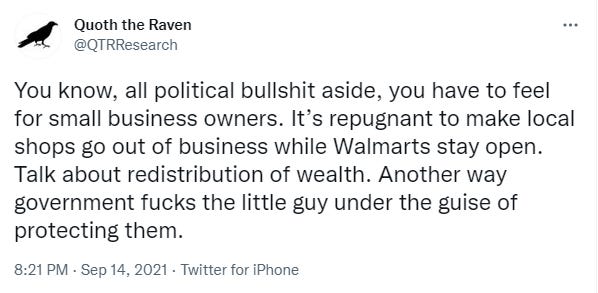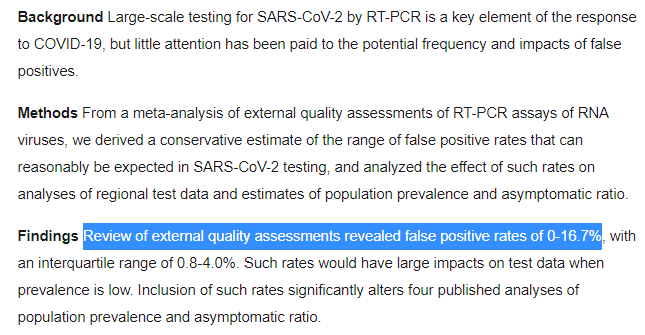A Nationally Televised Example Of The Chaos False Positive COVID Tests Create
Submitted by Quoth the Raven at QTR’s Fringe Finance,
Far be it for me to care much about what goes on during ABC’s The View, but for the fact that this week provided a nationally televised example of just how much chaos false positive PCR tests can randomly inject into our daily lives.
One moment, it’s a normal day at the office, the next, as co-host Ana Navarro described it this week, “it turn[s] into an episode of Curb Your Enthusiasm.”
In case you missed it because you were watching literally any other show that doesn’t feature Joy Behar’s “sense of humor” as one of its selling points, ABC’s The View was stopped in the middle of live taping this past week when producers awkwardly asked Navarro and fellow co-host Sunny Hostin to step off the desk and leave the studio in the middle of an episode.
Co-host Joy Behar then went to proceed with a planned interview of Vice President Kamala Harris before being notified by her producer that it wasn’t happening.
When Navarro appeared on CNN later in the evening to speak to Anderson Cooper, she revealed that after being pulled off the desk, she tested negative on two separate Covid tests. Navarro took a rapid antigen test and a PCR test, both of which came back negative, she told Cooper. Hilariously, The Hill reported Navarro still couldn’t fly back home to Miami without taking a third test and waiting for a negative result.
“It takes so much work to do an interview like this. We were very proud to have the vice president come on ‘The View’ and then it turned into an episode of ‘Curb Your Enthusiasm,’ it was surreal,” Navarro told Cooper.
The incident isn’t one I’d normally care to write about, but for the fact that I exist on the fringe and enjoy asking questions that others won’t. Even though I consider most common sense Covid cautionary measures (like protecting the vulnerable, washing your hands and staying home when you’re sick) to be just fine, I have to ask: have we considered false positive tests when we consider the cost/benefit analysis of all of the combined Covid measures we’re taking?
We’ve talked about the mental health toll of keeping people locked down, we’ve considered the ridiculous nature of mask mandates and we’ve debated the merits of forcing small businesses and churches shut while Targets and Wal-Marts remain open for business.

<!–*/
*/
/*–>*/
I do understand the need to be extremely cautious around the Vice President of the United States, but this incident was a good reminder that false positive testing has been an issue that has slipped through the cracks and hasn’t been considered enough when we think about the downsides of our Covid response.
If testing positive for Covid upends your life and the lives of those around you, despite not having symptoms, what threshold would the rate of false positives need to hit in order for our often drastic reactions to be counterintuitive?
With antigen tests, the FDA says that false positives can occur at a range of intervals, between 4% and 70% depending on disease prevalence:
Remember that positive predictive value (PPV) varies with disease prevalence when interpreting results from diagnostic tests. PPV is the percent of positive test results that are true positives. As disease prevalence decreases, the percent of test results that are false positives increase.
For example, a test with 98% specificity would have a PPV of just over 80% in a population with 10% prevalence, meaning 20 out of 100 positive results would be false positives.
The same test would only have a PPV of approximately 30% in a population with 1% prevalence, meaning 70 out of 100 positive results would be false positives. This means that, in a population with 1% prevalence, only 30% of individuals with positive test results actually have the disease.
At 0.1% prevalence, the PPV would only be 4%, meaning that 96 out of 100 positive results would be false positives.
Health care providers should take the local prevalence into consideration when interpreting diagnostic test results.
Another pre-print study shows false positives using PCR tests between 0% and 16.7%

<!–*/
*/
/*–>*/
“Our analysis of two regional data sets demonstrates the potential for a high frequency of false positives, especially when test positivity is low,” the study says.
The same study lays out the obvious negatives of a high frequency of false positives:
In hospitals, there can be wasteful consumption of personal protective equipment in caring for false positive patients, while at the same time the unnecessary use of such equipment and other protective measures may impede the care of the patient. In respiratory patients, a false positive test result may impede a correct diagnosis, delaying or depriving such patients of appropriate treatment.
The presence of false-positive patients may hinder the development of improved medical care for COVID-19 patients based on clinical experience, because incorrectly diagnosed patients introduce noise into clinical observations. Over the longer term, if antibody or antiviral treatments become available for COVID-19 patients, or if prophylactic treatments are developed for asymptomatic or mildly symptomatic individuals that have tested positive, false-positive individuals may be subjected to medically inappropriate treatments.
15 Clinical trials of potential treatments could lose statistical power by unwittingly enrolling false-positive individuals, who would be exposed to potentially harmful side effects without any mitigating potential for benefit.
Another study from January 2021 predicts false positives of up to 5% and notes that “false positive results in [a setting of low prevalence] can have several adverse effects.” It lists some of these as:
-
unnecessary treatment and investigation
-
missing or delayed surgery
-
unnecessary isolation and contact tracing with subsequent negative impact on workforce and resources
-
a risk of subsequent increased exposure if the individual changes their behaviour as a result of believing that they have been infected
-
the individual being placed with other inpatients with COVID-19 and consequently exposed to the virus.
Yet despite the reality of false positive tests, no one talks about them publicly and the idea of them has been “debunked” by mainstream outlets like the CBC, who said in June of this year:
One of the most common false claims is that PCR tests are prone to huge numbers of false positives, and this is often rooted in a misunderstanding of how the tests work, says Jonathan Jarry, a biological scientist with McGill University’s Office for Science and Society in Montreal.
Molecular biology is complicated, and Jarry said it’s easy for people to pick up on a tidbit of information that, in itself, is true but then jump to much larger conclusions that are not accurate.
“We’re all susceptible to it,” he said.
“I’m not accusing other people of being dumb or stupid or ignorant. These are biases that we all have to deal with…. It’s just part of being human.”
Speaking of a “part of being human”, remember when we used to actually be able to live our lives in some semblance of peace?
And also: have we bore witness to any other “debunked” conspiracy theories that actually wound up holding water?

<!–*/
*/
/*–>*/
The truth is that while Covid has certainly thrown a wrench in the gears of our day-to-day lives, I can’t help but think of how much our overreaction to it creates inefficiency and chaos to the point of exacerbating things.
The timing of the debacle on The View was interesting: I had just written an article about how I thought mask mandates were becoming spurious and burdensome and I was just subjected to two real world examples of what I can only describe as massive overreactions to what otherwise would be normal every day situations due to Covid.
The first situation involved a coffee shop barista telling me I couldn’t use an outlet for my laptop “because of Covid”. After letting her know how ridiculous her reasoning was, she altered her reasoning to include expert analysis that my laptop would trip a breaker that an air fryer was plugged into. Sigh.
Additionally, a close friend‘s son under 10 years old had his sporting event nearly canceled recently – not because a child tested positive for Covid – but only because the child “had been exposed” to Covid. This set off a chain reaction that lasted days, with parents arguing about changing schedules and what precautions should or should not be taken as a result. After everything was said and done, the child turned out to not even have Covid, meaning the entire instance was a gross overreaction.
Lest we forget the whole world has “been exposed” to Covid.
After living through these real world examples (both happened with 24 hours of one another) and then watching what happened with The View, I can’t help but wonder how much useless inefficiency we are voluntarily introducing into our lives not only by ignoring the accuracy of PCR tests and always assuming they’re accurate and the result are ironclad. Because they aren’t.
But this marks just another brick in the wall of what I continue to believe is a vast overreaction to a problem that we were too late in identifying.
Any type of reasonable risk reward analysis at this point suggests to me to take care of the vulnerable while letting the rest of the country return to life as it once was.
Now, if you’ll excuse me, I have to run.

<!–*/
*/
/*–>*/
* * *
Enjoy this free look at a paid subscriber article? Zerohedge readers get 10% off an annual subscription to my blog by using this special link here.
Tyler Durden
Sat, 09/25/2021 – 15:00![]()
Zero Hedge’s mission is to widen the scope of financial, economic and political information available to the professional investing public, to skeptically examine and, where necessary, attack the flaccid institution that financial journalism has become, to liberate oppressed knowledge, to provide analysis uninhibited by political constraint and to facilitate information’s unending quest for freedom. Visit https://www.zerohedge.com